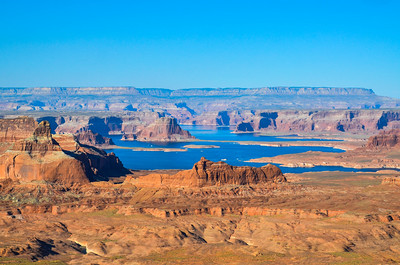If Colorado decides to join in an historic Colorado River drought protection effort, one that would require setting aside as much as 500,000 acre-feet of water in Lake Powell, can it find a fair way to get the work done? A way that won’t cripple farm economies and one which ensures Front Range cities bear their share of the burden?
That was one of the key questions more than 100 people, citizen volunteers and water managers, addressed last week as part of a two-day meeting in Denver to continue exploring whether the state should participate in the effort. The Lake Powell drought pool, authorized by Congress last year as part of the Colorado River Drought Contingency Plan, would help protect Coloradans if the Colorado River, at some point in the future, hits a crisis point, triggering mandatory cutbacks.
But finding ways to set aside that much water, the equivalent of what roughly 1 million average Colorado households use in a year, is a complex proposition. The voluntary program, if created, would pay water users who agree to participate. And it would mean farmers fallowing fields in order to send their water downstream and cities convincing their customers to do with less water in order to do the same. The concept has been dubbed “demand management.”
Among the key issues discussed at the joint Interbasin Compact Committee and demand management work group confab last week is whether there is a truly equitable way to fill the drought pool that doesn’t disproportionately impact one region or sector in the state.
In addition, a majority of participants reported that they wanted any drought plan to include environmental analyses to ensure whichever methods are selected don’t harm streams and river habitat.
Some pointed to the need to identify “tipping points” when reduced water use would create harmful economic effects in any given community, and suggested that demand management be viewed as a shared responsibility.
Flipping the narrative of shared responsibility, participants said sharing benefits equally was important as well. They want to ensure that people selected to participate would do so on a time-limited basis, so that a wide variety of entities have the opportunity to benefit from the payments coming from what is likely to be a multi-million-dollar program.
“People are starting to get it,” said Russell George. George is a former lawmaker who helped create the 15-year-old public collaborative program which facilitates and helps negotiate issues that arise among Colorado’s eight major river basins and metro area via basin roundtables. He chairs the Interbasin Compact Committee, composed of delegates from those roundtables.
“It’s understood that we have to be fair about this and we have to share [the burden] or it won’t work. I think we’re making great progress,” George said.
The Colorado River is a major source of the state’s water, with all Western Slope and roughly half of Front Range water supplies derived from its flows.
But growing populations, chronic drought and climate change pose sharp risks to the river’s ability to sustain all who depend on it. The concept behind the drought pool is to help reduce the threat of future mandatory cutbacks to Colorado water users under the terms of the 1922 Colorado River Compact.
The public demand management study process, facilitated by the Colorado Water Conservation Board, has caused concern among different user groups, including farmers. Because growers consume so much of the state’s water, they worry that they are the biggest target for water use reductions, which could directly harm their livelihoods if the program isn’t implemented carefully and on a temporary basis.
In early 2019 the seven states that comprise the Colorado River Basin—Arizona, California and Nevada in the Lower Basin, and Colorado, New Mexico, Utah and Wyoming in the Upper Basin—agreed for the first time to a series of steps, known as the Colorado River Basin Drought Contingency Plan, to help stave off a crisis on the river.

Colorado River Basin. Credit: Chas Chamberlin
And while Lower Basin states have already begun cutting back water use in order to store more in Lake Mead, the four Upper Basin states are still studying how best to participate to shore up Lake Powell. For the drought pool program to move forward, all four states would need to agree and contribute to the pool. George pointed to Colorado as a leader among the four states, saying it would likely be responsible for contributing as much as 250,000 acre-feet to the pool.
“We appreciate the focus, dedication and collaboration of our work group members,” said CWCB Director Rebecca Mitchell in a statement. “This workshop was the next step in sharing ideas for Colorado’s water future, and positioning our state as a national leader for cooperative problem solving.”
The eight major volunteer work groups, addressing such topics as the law, the environment, agriculture and water administration, will continue meeting throughout the year, with a mid-point report based on their findings to date due out sometime this summer.
Travis Smith, a former CWCB board member from Del Norte who is now participating on the agriculture work group, said he is hopeful that the work groups will be able to come up with a plan the public will endorse. Any final plan will likely have to be approved by Colorado lawmakers.
“Coming together to address Colorado’s water future is something we’ve been practicing through the [nine river basin roundtables] for years. Will we get there? Absolutely,” Smith said.
Jerd Smith is editor of Fresh Water News. She can be reached at 720-398-6474, via email at jerd@wateredco.org or @jerd_smith.
Fresh Water News is an independent, non-partisan news initiative of Water Education Colorado. WEco is funded by multiple donors. Our editorial policy and donor list can be viewed at wateredco.org


 Print
Print